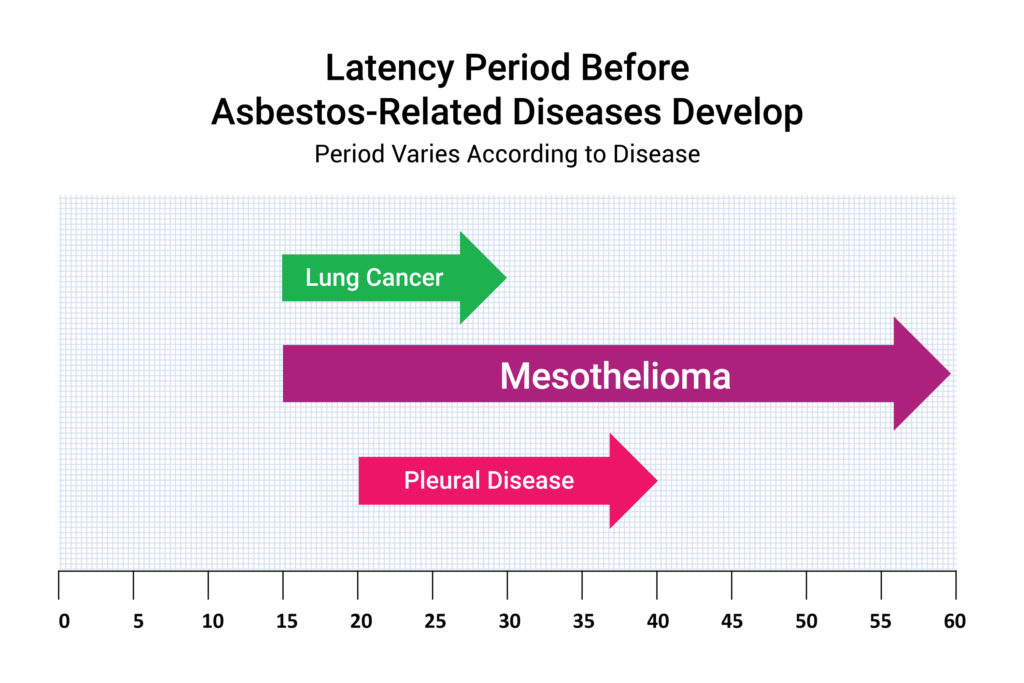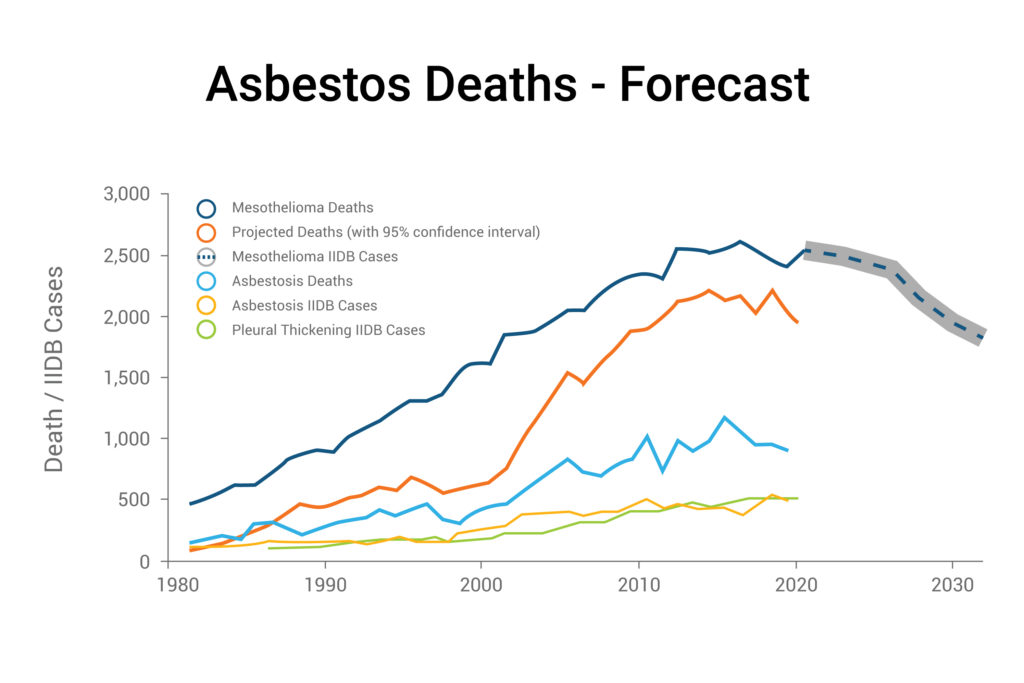
This article provides a short guide on how asbestos exposure can affect your health. We will look at how dangerous is asbestos and the risks associated with asbestos fibre release. We’ll also explain asbestos-related diseases and asbestosis symptoms caused by exposure to asbestos and asbestos-containing materials.
Asbestos is highly carcinogenic and hazardous to health. It is responsible for causing hundreds of deaths and illnesses each year. Commonly used in building materials and other products up until the mid-1980’s, asbestos is still found in buildings across the UK that were constructed before the year 2000.
Asbestos, in its raw form, consists of long, very thin, threadlike fibres that are microscopic and almost invisible. Fibres become readily airborne and are easily inhaled. Their unique needle-like shape allows them to penetrate the soft lining of the lungs.
When material such as dust is inhaled, it is usually prevented from entering the lungs by various parts of the respiratory system. Reflex mechanisms, such as coughing, force such material from the lungs. Unfortunately, due to their unique shape, asbestos fibres do not always get removed. This can lead to asbestos related diseases and serious health problems.
What Are the Main Asbestos-Related Diseases and Their Symptoms?
The four main asbestos-related diseases are difficult to diagnose – they are:
- Asbestosis
- Lung Cancer
- Mesothelioma
- Disease of the pleural cavity in the lungs
Let’s take a closer look at the main asbestos-related diseases.
Asbestosis
Asbestosis is an asbestos disease for which there is no cure.
The asbestosis symptoms are similar to the symptoms for all of the asbestos-related diseases and include:
- Shortness of breath
- A persistent cough
- Wheezing
- Extreme fatigue
- Pain in the chest or shoulder
- Clubbed (swollen) fingertips
Asbestosis is the non-malignant scarring of the tissue of the lungs and surrounding tissues that is caused by asbestos fibres. The repeated process of scarring, or fibrosis, causes a loss of flexibility in the tissues of the lung. This results in increased asbestosis symptoms, including breathing difficulty that can lead to fatal complications.
It is largely acknowledged that heavy asbestos exposure is required in order to produce clinically significant asbestosis within the lifetime of an individual. Asbestosis frequently leads to premature death.
Lung Cancer
The second of these diseases is lung cancer. Exposure to asbestos is only one of a number of causes of this serious disease in which benign or malignant cell growth arises inside the lung structure. This risk is particularly increased for asbestos workers who smoke.
Smoking and asbestos exposure, together, raise the risk of lung cancer by approximately 53 times, compared to those who are exposed to asbestos-containing materials but do not smoke.
Symptoms of lung cancer include:
- A persistent cough
- Regular chest infections
- Coughing up blood
- Pain when breathing or coughing
- Breathlessness
- Tiredness and lack of energy
- Loss of appetite or weight loss
Mesothelioma
The third disease is malignant mesothelioma, which is always fatal. The majority of fatalities that are occurring now are a consequence of past occupational exposures to asbestos when it was used extensively in the building industry.
Mesothelioma is an asbestos cancer affecting the linings of the chest or the abdominal cavities, or both. This is a result of the migration or movement of microscopic asbestos fibres around these cavities.
Mesothelioma can be caused by relatively low exposure to asbestos dust, but the higher the level of exposure, the higher the risk of developing mesothelioma will be.
The number of deaths from mesothelioma is predicted to increase until the end of this decade, according to the Health and Safety Executive (HSE).
The symptoms of mesothelioma are:
- Chest pain
- Shortness of breath
- Extreme fatigue
- Fever and night sweats
- Persistent coughing
- Loss of appetite
- Unexplained weight loss
- Clubbed (swollen) fingertips
Disease of the Pleural Cavity
The fourth most common asbestos disease is the disease of the pleural cavity in the lungs. This disease is non-malignant, which means that it is non-cancerous, but is still potentially disabling. There are two types of disease of the pleural cavity in the lungs: pleural thickening and pleural plaques.
Pleural thickening occurs when asbestos fibres are inhaled into the lungs and the fibres work their way out and embed themselves in the pleura. The pleura is the thin membrane which lines the lungs and the inside of the rib cage. When the asbestos fibres become lodged in the pleura it can cause fibrosis, scarring, calcification and thickening of the pleura.
When the pleura thickens, it reduces the elasticity of the lungs and contributes to reduced lung function. This causes symptoms in sufferers that are similar to asbestosis symptoms, such as:
- Shortness of breath
- Chest pain
However, many cases show no asbestos symptoms at all and are only identified from x-rays.
If the thickening is localised to a few patches, the condition is known as pleural plaques. This condition does not generally cause symptoms.
How Do Asbestos Fibres Damage Our Lungs
When asbestos fibres become embedded in the lining of the lung, they cause the body to react to their presence by producing scar tissue or abnormal cell growth. These are known as pleural plaques, areas of scar tissue form on the pleura which is a two-layer membrane surrounding the lungs.
Due to its unique size and shape, asbestos fibre can also pass through lung tissue into other areas of the body.
As well as the damage caused by having asbestos in lungs, there is another process that damages the body from asbestos exposure. As asbestos fibres become embedded in human tissue, our immune system dispatches a special cell known as a macrophage. These cells wrap themselves around the asbestos fibres in order to try and remove them. However, not all macrophage cells are successful in this removal process. As a result, they build up over time.
There is also a chemical reaction that gives off a compound known as Reactive Oxygen Species or ROS. ROS can damage human DNA and lead to the build-up of fluids and scar tissue.
When Do Asbestosis Symptoms Appear?
One of the main problems is that the effects of exposure to asbestos fibres in asbestos-containing materials are not immediate. The time delay, or latency period, before asbestos-related diseases develop, is anywhere from five to 15, or even up to 60 years.
The latency period varies according to the type of disease:

Smoking and asbestos exposure together significantly increase the health risks, compared to those who are exposed to asbestos-containing materials but do not smoke. Smoking damages the lungs’ inbuilt self-cleaning system which makes it harder for the body to clear out asbestos fibres. Smoking also increases inflammation and scarring in the lungs.
As the effects of asbestos disease and asbestos cancer are not immediate, it can be tempting to dismiss the risks and avoid taking the necessary safety measures. However, whenever there is a risk of asbestos exposure, stringent safety protocols should be adhered to.
How Dangerous is Asbestos?
Blue and brown asbestos are considered to be the most dangerous types of asbestos. These types of asbestos have both been scientifically linked to causing a cancer called mesothelioma. Both types were banned from importation and use in the United Kingdom in 1985 under the Asbestos (Prohibitions) Regulations 1985.
White asbestos, which was considered less harmful, was banned (except for a few specialised applications) in 1999 under the Asbestos (Prohibitions) (Amendment) Regulations 1999.
Can a single exposure to asbestos give rise to an asbestos-related disease? The answer is that we simply don’t know for sure, but this is a distinct possibility. All exposures to asbestos should be avoided because there is no known safe limit.
Prevalence of Asbestos Disease in the UK
According to the latest asbestos-related disease figures for Great Britain published by the HSE the country averages over 5,000 asbestos-related disease deaths per year caused by diseases such as mesothelioma, lung cancer and asbestosis.
There has been a trend of increasing fatalities over the last 40 years. Asbestosis accounted for 530 deaths in 2020. However, the HSE is predicting that the number of deaths from mesothelioma may have peaked and will begin to decline over the coming decades.
At the moment, however, these health statistics show that 20 workers in the UK per week are dying from asbestos-related diseases. It is certain that asbestos-related diseases will continue to take a toll on families throughout the UK for years to come. Click here for an infographic about asbestos related diseases.

Being Safe Around Asbestos
Asbestos-related diseases claim the lives of people throughout the UK every year. Unfortunately, it can be years before asbestosis symptoms or any other symptoms even begin to appear.
Although now banned across the UK, asbestos is a major health hazard that can be still found in many older buildings and products. Staying safe means having the right training to know where you might encounter asbestos and what to do if you suspect there is asbestos-containing material. Click here for a free poster to remind workers about the importance of the possible presence of asbestos in the workplace.
You can find a selection of approved asbestos training courses on the Human Focus website. These courses provide a thorough understanding of the dangers of asbestos and how to stay safe in the workplace.





























































































































































































































































































































































































































































































































































































































































































































































